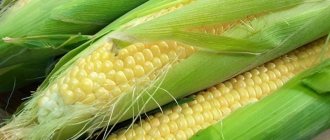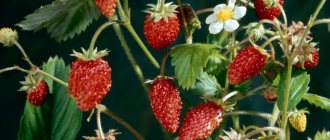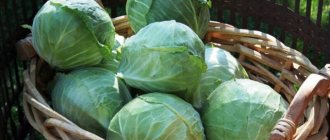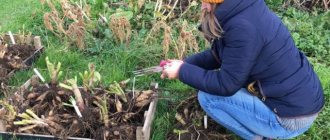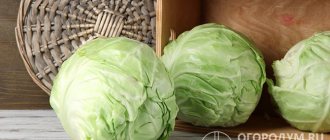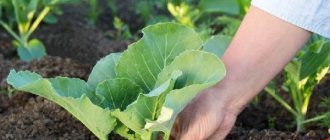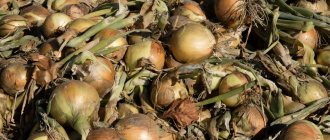Kohlrabi cabbage, how to store in winter. Ripening dates or when to harvest
The growing season for kohlrabi is short: 2-3 harvests can be harvested per season.
But novice gardeners often cannot understand that kohlrabi is ripe, and as a result they are late with timely harvesting. When to harvest kohlrabi and how to determine ripeness, the plant itself will tell you: the size of a mature stem fruit is close to 8-10 cm in diameter. A normal stem fruit of early and mid-ripening varieties should weigh 100 grams by the time it is necessary to cut kohlrabi. Late-ripening hybrids often approach the value of 500-600 g. The crop is harvested selectively, in several passes. You should not overexpose it in the garden: the cabbage will lose its inherent tenderness, become fibrous and rough, and acquire a bitter taste.
Early varieties with delicate skin are not suitable for long-term storage. The ripening period for kohlrabi of early ripening varieties usually falls in July-August. Early kohlrabi, after being collected from the garden, is usually used fresh for food; some freeze it, while others can it.
Only late-ripening varieties with rough skin, absolutely healthy, without spots or damage, are suitable for winter planting. Those sown in June are good for this purpose:
- Giant;
- Violet;
- Natalka;
- Delicacy blue;
- Kossak F1.
Stem fruits whose color is dominated by blue-violet tones are better stored. Light-colored varieties tolerate winter storage much worse.
In order for the harvest to be stored well and for a long time, you should not delay harvesting kohlrabi in the fall (it is better to do this no later than October-early November). The harvesting work is completed and kohlrabi is stored for approximately the same period as white cabbage, when the growing season stops, the daytime temperature drops to +3-5⁰, and the night temperature, without reaching negative values, becomes close to 0⁰. Although kohlrabi is a cold-resistant plant, you shouldn’t wait until frost. This will negatively affect storage.
Diseases and pests dangerous to crops, methods of control and prevention
Kohlrabi suffers from the same diseases and pests as other varieties of cabbage. There are quite a lot of them, so you need to be able to identify them and know the appropriate control and prevention measures.
Among the pests that pose a danger to kohlrabi are:
- cabbage aphid. Pale green insects cling to the leaves and stem in a continuous mass. The stem fruit turns out to be small and deformed, damaged tissues change color to beige-yellow with a pinkish border. Strong-smelling herbs or infusions made from them growing near kohlrabi effectively repel aphids. You can also use onions, garlic, orange peel, and tobacco chips as raw materials. The same measure will help get rid of the pest if you increase the frequency of treatments from once a week to 3-4 times a day. In case of mass invasion of aphids, Inta-Vir, Fury, Iskra-Bio, Mospilan are used;
- cruciferous flea beetle. Small black bugs with a shimmering blue-green shell feed on the sap of the plant. Vague yellowish spots form on the leaves and stem, and the plant withers. Effective prevention - surrounding the bed with kohlrabi are marigolds, calendula, and tansy. Cotton swabs soaked in kerosene or turpentine are laid out between the rows. To combat the pest, Aktaru, Fosbecid, Actellik are used;
- cruciferous bug. Black-yellow bugs make round holes in the leaves, the larvae eat away the stems from the inside and gnaw at the roots. Control measures are the same as for the cruciferous flea beetle;
- cabbage moth. It eats away tissue from the inside, resulting in leaves and stems becoming covered with “tunnels.” Regular weed control is very important. Next to the kohlrabi bed, plants are planted that produce natural phytoncides - coriander, tomatoes, onions, garlic. Folk remedies for fighting moths are an infusion of hot pepper and tobacco crumbs. The most commonly used chemicals are Decis, Arrivo, Molniya;
- cabbage whites. Lime-colored caterpillars eat leaves, gradually moving from the edges to the middle. They can be collected by hand, but this is ineffective. Folk remedies are also not particularly effective. You can use traps against adult specimens - sheets of cardboard greased with jam or containers filled with sugar syrup or honey diluted with water. To cope with caterpillars, use Kinmiks, Fitoverm;
- cabbage scoop. Late ripening kohlrabi especially suffers from it. Caterpillars eat the stem fruits from the inside and contaminate the pulp with excrement. A folk remedy for preventing the appearance of the pest is an infusion of wormwood, burdock leaves or tomato tops. Among the chemicals used are Bankol, Sherpa, Iskra-M;
- cabbage fly. The larvae eat away the roots and stems from the inside. The plant abruptly stops developing, withers and dies. To prevent the appearance of cabbage flies, the soil in the garden bed is dusted with a mixture of tobacco dust with naphthalene, ash or camphor. To combat it, use any general insecticide.
When to harvest kohlrabi. Basic Rules
Kohlrabi cabbage: when to harvest and how to store?
Kohlrabi is a fairly early ripening crop. You can get up to three harvests per season. The first and second time, kohlrabi are not stored en masse, but selectively, as they ripen. And such cabbage is stored from 2-3 days at normal temperature to a month in the refrigerator.
Moreover, all varieties are suitable for this: both green and with purple peel. You just can’t miss the moment when the diameter of the stem fruit reaches 7-8 centimeters. After this, the kohlrabi becomes very rough both outside and inside.
Overgrown cabbage will lose its juiciness, become tough, fibrous and unsuitable for eating raw!
Some vegetable growers focus on the weight of the resulting stem crop. On average, summer harvest kohlrabi should weigh about 100 grams. Unlike early and mid-ripening ones, late-ripening hybrids often reach 500 - 600 grams. And under favorable conditions they can grow up to 10 centimeters in diameter.
To stock up on vitamins and health for the whole winter and even survive until the next harvest, you must follow the following rules:
- plant only purple-colored varieties, as they are more suitable for storage;
- The root crop is not cut, but pulled out of the ground by the roots;
- the roots are not washed, but only shaken off; they can be wiped with a soft cloth;
- the leaves are cut with a knife or sharp pruning shears, leaving petioles of 1-1.5 cm;
- put away in cold storage (underground, loggia) in boxes or simply folded into pyramids, lightly sprinkled with sand,
- the relative humidity in the storage room is optimally maintained at 95%, temperature - from zero to one degree;
- For storage, take uncracked, whole and healthy specimens of kohlrabi.
Late varieties with high keeping quality - “Violetta”, “Giant”, “Delicacy Blue”, “Kossak F1”.
To harvest kohlrabi, it is advisable to choose a dry, sunny day. Humidity doesn't really matter, but removing any vegetables in the rain means a much shorter shelf life.
If there was a light frost at night, we advise you to wait until noon, when the plant returns to normal in its internal functions.
The temperature for storing kohlrabi cabbage must be above zero. Ideally - 5 - 10 degrees.
To make it easier to pull kohlrabi out of the ground, it is useful to water the ground the day before harvesting. Read our articles on storing all types of cabbage at home and in a cellar or basement.
Landing
Kohlrabi is relatively unpretentious. It successfully takes root and bears fruit even on poor soils. But, of course, obtaining a bountiful harvest and stem fruits of the largest possible size in such conditions is impossible. The ideal option is a light but nutritious substrate, for example, loam.
Be sure to find out the acidity of the soil in advance. Kohlrabi, like any cabbage, cannot tolerate the acidic substrate categorically. Clubroot almost inevitably develops in such soil. The situation can be corrected by adding slaked lime, dolomite flour, and powdered eggshells (200–400 g/m²) when preparing the bed. Humus or rotted compost (10–15 liters per 1 m of bed) will help increase soil fertility.
Dolomite flour is a natural soil deoxidizer that has no side effects.
Kohlrabi is frost-resistant. Even seedlings that have just been transplanted into a garden bed and have not yet recovered from the “stress” can withstand short-term cooling down to -2ºС; adult plants are not damaged if the temperature drops to -8ºС. But kohlrabi does not like heat and direct sunlight. This must be taken into account when choosing a place for a garden bed.
Kohlrabi does not tolerate extreme heat very well; it negatively affects the quality of the fruit.
Landing dates
Early varieties of kohlrabi are most often grown as seedlings to speed up the harvest time. Late ones, since the frost resistance of the crop allows, are planted immediately with seeds in open ground, covered with plastic film or other covering material.
Seeds of early varieties of kohlrabi are planted for seedlings at the end of winter or at the very beginning of March. The harvest ripens by the end of May. After about 2–3 weeks, the same varieties are re-sown as seedlings for the second “wave” of fruiting, which occurs at the end of summer. To get a harvest during the summer, early and mid-season kohlrabi are planted both as seedlings and as seeds in open ground in April. The optimal time for late varieties is the last ten days of May or the beginning of summer.
Kohlrabi seeds can be planted both as seedlings and directly in open ground.
Seedling preparation procedure
- The seeds are immersed in hot (45–50ºС) water for 15–20 minutes, then immediately in ice water, literally for a minute or two. Next, they are soaked for 10–12 hours in a solution of any biostimulant (Epin, Zircon, potassium humate). Folk remedies are also suitable - succinic acid, aloe juice.
- After the specified time, the seeds are washed and wrapped in a damp cloth or napkin. Then they are placed in the warmest place in the apartment. For example, you can put them in a saucer and place them on a radiator. The fabric must be constantly sprayed with a spray bottle, not allowing it to dry out.
- After 2-3 days, the seeds should hatch. When this happens, they are placed one at a time in small plastic cups or peat pots. This allows you to do without picking, which kohlrabi really does not like - a significant number of seedlings die after the procedure.
- Soil: universal soil for seedlings or a mixture of peat, humus and fertile turf in approximately equal proportions.
- The seeds are buried to a maximum of 1–2 cm.
- The pots are covered with plastic bags to create a greenhouse effect and transferred to a dark, warm place. The optimal temperature is 20–22ºС. As soon as the seedlings appear, they are provided with light and the temperature is sharply lowered to 8ºC. After 8–10 days it is raised again to 17–20ºС during the day and 11–13ºС at night. If it is warmer, the plants will stretch out unsightly.
- To prevent the development of “black leg,” kohlrabi seedlings are watered only with water at room temperature, alternating it with a pale pink solution of potassium permanganate. When the plants have formed two true leaves, they are fed with a solution of any complex fertilizer for seedlings (Rostock, Ideal).
- They begin to prepare seedlings for planting about 2 weeks in advance, hardening them off. The time spent outdoors is gradually extended from 1–2 hours to 10–12 hours. A week before planting, kohlrabi stops watering.
Shoots from kohlrabi seeds appear quickly and uniformly
Planting seedlings in the ground
Kohlrabi seedlings are ready for planting in the ground a month after seedlings appear. It should have 3-5 true leaves standing upright. It is not recommended to delay disembarkation. The stem fruit will either not form at all, or it will be deformed, and the pulp will be hard, not juicy, and fibrous.
Early kohlrabi seedlings are planted as soon as the soil warms up to 8–10ºС. If you delay, the plants may go into the “arrow”. The late ones are transferred to open ground in the second decade of July in order to harvest in September or the first half of October.
Kohlrabi differs favorably from other types of cabbage in that each plant needs a very small area for nutrition. About 20–25 cm are left between them, and about 30 cm between rows. Thus, 8–10 plants “get along” per 1 m².
Kohlrabi for the winter. Kohlrabi - recipes for preparing preparations for the winter
Kohlrabi is a very tasty and healthy stem fruit, reminiscent of something between a turnip and the stalk of white cabbage, only unlike the stalk, kohlrabi is juicier and more tender. Such cabbage cannot be stored fresh for too long, and over time it becomes coarser and loses its valuable properties.
Kohlrabi preparations for the winter can be very diverse. It is included in recipes for canning mixed vegetables and salads. It can also be preserved on its own. In addition, this cabbage can be preserved by freezing and drying.
If you want to prepare fresh kohlrabi for future use, then you need to do it correctly, then the vegetable can be preserved for up to 5 months.
The best way to keep the fruits fresh is to transplant the plant along with garden soil into a bucket or box, cut off its leaves, leaving only small petioles. Cabbage should be stored in a cool cellar.
If you live in an apartment and you can only dream of a cellar for preparations, you can also prepare kohlrabi. To do this, unwashed fruits are wrapped in a moistened paper towel and placed in a plastic bag. In this form, the cabbage is stored in the refrigerator, preferably on the shelf where the temperature is 0 degrees. The bag is not tied, allowing the kohlrabi to breathe. With this method, it will be possible to preserve the cabbage a little longer than if it were simply placed in the refrigerator compartment for vegetables.
More options for preparing kohlrabi preparations can be found in step-by-step recipes with photos in this section. Follow all the recommendations of the chosen recipe and you are guaranteed a delicious preparation for the winter!
Storage conditions and periods
The dependence of the shelf life of kohlrabi on the chosen location or storage method is shown in the table below:
Shelf life of kohlrabi (table)
During storage, it is important to maintain the temperature no higher than 0-2 °C, humidity - within 95-100%. It is desirable that air circulate freely in the room, which will prevent the growth of mold and bacteria. If the conditions are met, it is possible to keep vegetables fresh for a long time.
Do you know that…
To provide the necessary humidity, just place a container of water in the storage and add liquid as it evaporates.
What preparations can be made from kohlrabi. Canning kohlrabi
Prepare the kohlrabi. Rinse off dirt. Dry with a towel. Remove the skin with a vegetable peeler. Chop into long thin strips. To do this, use a Korean carrot grater. Place in a convenient deep container.
Wash and peel the carrots. Chop it the same way as kohlrabi. Add to cabbage and mix well.
Take clean jars. Place washed celery sprigs, sweet peas, and garlic cloves on the bottom. Add the prepared vegetables and compact them a little.
Boil water in a saucepan. Add sugar, salt. Stir until dissolved. Pour in vinegar. Bring to a boil and turn off.
Pour hot brine into jars with cabbage. Cover with clean lids. Cover the saucepan with a cloth and place the jars. Pour warm water up to the neck of the jar and place on the fire. Bring to a boil.
Kohlrabi has a fairly dense consistency, and in order to eat it, you can cook it accordingly. Marinating kohlrabi for the winter involves cutting it into separate small elements, which will marinate completely and absorb the spices.
Thanks to the addition of allspice to the recipe, the marinade turns out aromatic, which means the whole mass will be saturated with these aromas. Vinegar helps make a piquant marinade that will better saturate the flesh. You won’t have to store this preparation for too long; it is too tasty to be stored for a long time.
Required ingredients:
- Kohlrabi – 500 grams;
- Pepper – 2 allspice;
- Garlic – 3 cloves;
- Laurel – 2 leaves;
- Salt – 13 grams;
- Water – 250 milliliters;
- Vinegar – 20 milliliters;
- Sugar – 20 grams.
Pickled kohlrabi for the winter recipes:
- Wash the cabbage pulp, peel it and cut it into triangular plates; they should have a thickness of no more than 5 millimeters; you can use special shredders that thinly slice the pulp;
- After this, the mass is poured with water, the water should completely cover the pulp, pour vinegar into the mixture and boil for 15 minutes;
- After cooking, turn off the stove and leave the mixture until it cools completely;
- Then transfer the boiled pulp into glass jars, compact it a little and set aside;
- Separately, cook the marinade from water, to which add a measured amount of salt, sugar, bay, pepper and garlic. Boil the entire mass for no more than 1 minute after it boils. Only after cooking, add vinegar to the mixture and pour the prepared solution over the pulp;
- Roll up the lids on the jars and wait until they cool down. Place the cooled pieces in the refrigerator for three days. Then you can taste the mass, or you can store it all winter. It is better to store at low temperatures so that the mass does not sour.
Reviews from gardeners
★★★★★
Natalya, 47 years old, Southern Urals. This is only the second year I’ve been planting kohlrabi, the Viennese white variety.
I like it in salads, grated. I pick it young, then it is tender and tasty. Over the summer I destroy the entire crop, and in the fall other cabbages are suitable. ★★★★★
Oksana, 35 years old, Yekaterinburg. I just love kohlrabi!
It is not worth growing it to large sizes, because hard fibers appear and it becomes less juicy. I like the purple varieties the most. It is very useful due to the large amount of silicon. ★★★★★
Oleg, 56 years old, Moscow region. I planted a hybrid kohlrabi, Korist.
A very juicy vegetable, eat it like an apple! But what I liked most about it is that it does not form coarse fibers and does not overgrow. This year I will try to plant this variety twice: with seedlings in the spring, and then in open ground in the summer. Hide
Add your review
Growing kohlrabi cabbage is not very difficult, especially for those people who have already grown other types of cabbage on their plot. During the season you can get 2 or even 3 harvests and enjoy this vegetable throughout the summer.
0
0
Copy link
How to cook kohlrabi for a child. How to make kohlrabi soup?
From this variety of cabbage you can prepare a delicious creamy soup that is in no way inferior to, for example, broccoli dishes. To diversify the taste and make the dish more satisfying, we suggest using mushrooms.
For this recipe you should prepare: 125 g of boiled champignons, 40 g of butter, 2 kohlrabi, yolk, 0.5 tbsp. cream and salt.
- Peel the cabbage like potatoes, first removing the leaves. Cut it into small pieces, place it in a pan with water and boil. Place the prepared vegetables and rub them through a sieve;
- Dilute the resulting puree to approximately 3.5 tbsp. broth remaining after cooking. Add more salt. Place on the stove and cook over low heat after boiling for 3 minutes;
- Beat the yolk with melted butter and cream. Pour the resulting mixture into the soup. Add chopped mushrooms. Serve with croutons if desired.
Stuffed kohlrabi
If you don't know what you can make from kohlrabi, then use this recipe. The dish turns out very satisfying and tasty. It is impossible not to note its attractive appearance.
For this dish you should take the following ingredients: 2 cabbage, carrots, onion, egg, 50 g butter, 2 pieces of cheese, salt and pepper.
Step-by-step cooking process:
- Wash the cabbage, remove the top and carefully peel the skin. Using a spoon or any other object, remove the core so that the walls are at least 7 mm thick. Dip the resulting “cups” into boiling, lightly salted water and hold for 8 minutes;
- Peel the washed carrots and cut them into small cubes, and also chop the onion. Take a saucepan, melt the butter in it and fry the onion in it, then add the carrots and continue cooking over medium heat, stirring constantly, for 5 minutes. Place the pieces of cabbage that you took out from the middle there and cook until soft. Add salt and pepper to taste. Beat the egg into the pan, stir quickly and remove everything from the stove;
- Stuff the prepared “cups” with the resulting vegetable filling and place them in a baking dish. Pour in 1 tbsp. water. Cook in an oven preheated to 180 degrees until soft. A few minutes before the end of baking, place a piece of cheese on top to make a beautiful cap. A delicious and incredibly healthy dish is ready. Bon appetit!
Choosing a variety for storage
There are many different varieties of this delicious vegetable: Korist, Vienna, Russian size and others. The earliest ripening variety is Korist. It ripens by mid-July and reaches 6-8 cm in diameter. Gigant, Vienna, Russian size are later varieties of kohlrabi. This type of cabbage grows until late autumn and reaches a diameter of 10-12 cm.
If you want to preserve the fruits for as long as possible, you should choose late and medium-type kohlrabi varieties, with a denser structure and good resistance to frost. For example: Giant, Kossak F1, Violetta, Globe, Russian size, Karatago F1, Azur, Blue Planet F1. They rarely crack or become woody.
Types of cabbage that ripen in June are best used immediately; they can be stored in the refrigerator for a couple of weeks - these are Moravia, Ateka, Sonata F1, Vienna White 1350 and others.
On a note!
The larger the kohlrabi in diameter, the tougher its root part.
Assorted kohlrabi for the winter. Recipes for delicious kohlrabi preparations for the winter
- Knowing how to pickle kohlrabi for the winter, you can eat this dietary vegetable with health benefits all year round. Kohlrabi is a type of cabbage in which it is not the leaves that are edible, but the stem, which looks like a round turnip. In terms of vitamin C content, this vegetable is superior to oranges; it contains a lot of sulfur and potassium, which are beneficial for healthy skin and hair. The juicy and sweetish pulp of kohlrabi resembles the stalk of young white cabbage, but without the sharpness and bitterness.
- Number of servings: 3
- Preparation time: 10 minutes
- Cooking time: 30 minutes
For winter preservation, choose young kohlrabi weighing up to 200 g.
Photo: Getty
Recipe for assorted vegetables with kohlrabi cabbage for the winter
For cooking, choose young kohlrabi cabbage, with tender and juicy pulp.
Preparation:
- Cut the washed and peeled young kohlrabi stalk into thin slices or cubes.
- Blanch in hot, salted water for 2 minutes. Place the kohlrabi in a colander to drain.
- Cut the peeled and washed vegetables: carrots and onions into rings, pepper into strips.
- Place mustard seeds at the bottom of sterilized jars, add bay leaves, allspice and peeled garlic.
- Mix all the chopped vegetables in a bowl and place them in jars.
- Cook the marinade by adding 500 ml of water, 1 tbsp. l. sugar and 20 g of salt, and at the end 2 tbsp. l. vinegar. Pour the marinade over the vegetables and cover the jars with clean lids.
Sterilize mixed vegetables in a saucepan with water for 10 minutes. Roll up the finished salad and wrap it in a blanket until it cools.
Adviсe
These recommendations will help preserve kohlrabi until spring:
- For cabbage to grow juicy, the soil must be sufficiently moist. When the soil is dry, the stem fruits become hard, coarse and tasteless. Cold and heavy soil is also not suitable for growing kohlrabi.
- It is best to sow seeds in a row at a distance of 40-60 cm, so that the optimal feeding area remains.
- It is imperative to thin out the cabbage 5-7 days after the seeds germinate. Leave early ripening varieties at a distance of 10-15 cm from each other, late ripening varieties at a distance of 20-25 cm.
- The best size for late varieties is 10-12 cm in diameter and 6-8 cm for early varieties. You should not overgrow stem fruits. Otherwise, the fibers will coarse, and the cabbage will become tough, tasteless, and lose its beneficial properties. It will also be impossible to store such heads of cabbage for a long time. Kohlrabi root can be stored for a long time, sometimes until summer.
- When storing stem fruits in cling film, you need to periodically check it for condensation. If drops of water are found under the film, the old film should be thrown away. Dry the kohlrabi with a towel and replace the film.
Kohlrabi cabbage is one of the most unpretentious crops of the cabbage family, it grows well, is not afraid of frost, has many different storage methods, and contains a large amount of useful substances. It can be fried, pickled, boiled, stewed, cooked with casseroles, salads, or eaten raw. The diversity of this vegetable allows you to choose the most suitable variety of stem fruit for storage and cooking. Even a novice summer resident can grow kohlrabi.
Growing conditions
The site should be sunny (it will ripen faster), without stagnant moisture.
Humus-rich, light and well-moistened soils with sufficient lime content. Sandy soil - make a 10 cm clay cushion under the bed and apply organic fertilizers.
It is impossible to apply fresh or not completely rotted manure - the plants can get clubroot.
A few more important nuances:
- Poor soils affect the taste of the vegetable - the stem fruit can turn out bitter and tough. Before planting, rotted manure and complex mineral fertilizer for cabbage are applied to the garden bed.
- If the soil is acidic, the fruits will be tough and If the soil is acidic, the fruits will be tough and fibrous. The acidity of the soil can be reduced by adding wood ash (2 cups per 1 sq. m) or lime, dolomite or bone meal (up to 350 g per 1 sq. m) to the soil.
@Sabine Marzahn, Flickr
Kohlrabi is often used as a compactor in late-ripening cabbage plantings. It also goes well with cucumbers and tomatoes.
Good predecessors:
- legumes,
- potato,
- pumpkin,
- carrots, beets,
- tomatoes.
Planting as a repeat crop after:
- salad,
- spinach,
- onions on greens.
Bad predecessors:
Turnips, radishes, rutabaga, turnips, watercress. It is also not worth planting in areas after other cabbage varieties.
Planting kohlrabi seedlings in the ground
March seedlings are planted in the garden at the end of April - beginning of May. For better survival of seedlings, planting is carried out in cloudy weather or in the evening:
- Place according to the 25*30 cm pattern (increase the distance for later varieties).
- Planting depth is just above the cotyledon leaves.
Before planting, add a glass of humus or 2 tsp each to the holes. urea and superphosphate per 1 sq. m.
When planting, you must try not to destroy the earthen ball around the roots. After planting and watering, it is useful to mulch the holes.
For the first time after planting, it is useful to cover the seedlings with film or agrofibre. It is also worth covering when there is a threat of night frosts - they can slow down the development of the fetus.
@vigilant20 (דָרוּך), Flickr
